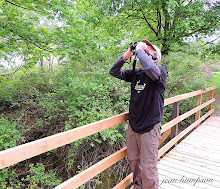We all have our own rules when keeping lists of the birds we see and for our life list, both Jean and I have to see the bird to add the tick. Our rules are not set in stone and some even have an elastic attached. But simply hearing a bird sing or call did not suffice for the 454 species we have encountered over the years. Once we have seen the bird and it's on the life list, then every subsequent observation will count when the bird is heard and not seen.
When thinking of troublesome additions to the life list,
Yellow Rail comes to mind. Though they are easily heard when standing in the right environment, seeing them is another matter. A very difficult one at that. So when we do hear the "tic-tic, tic-tic-tic" of the Yellow Rail, which resembles two stones tapping together, it will be a lifer.
On June 15, another trying species appeared on our eBird Year Needs Alert. Along with Merlin, Eastern Whip-poor-will was observed the day before by our friend Marcie. The small falcon in Port Colborne could wait. Chasing after an Eastern Whip-poor-will was the better of the two ticks for a couple of reasons. An addition to the life list and an assist at keeping Jean and I near the top of the table on the 2016 Niagara eBirders list. More on that chase in a later post.
With
Eastern Whip-poor-will being a nocturnal species, a heard only observation was most likely to occur if we encountered the bird. We started our search at the south end of Willson Road in Wainfleet.
The gravel road is the western border for the Wainfleet Bog and it is perhaps the closest I'm willing to venture into the bog that is home to Deer Ticks carrying the bacteria that cause Lyme Disease. It was raining so I would drive a 100 metres or so and stop and lower the windows and listen to the birds that did not seem bothered by the evening precipitation. Birds already on the year list that were heard included, Yellow Warbler, Wood Thrush, Veery, Gray Catbird and Song Sparrow. Robins darted across the road and blackbirds flew overhead. Jean caught a glimpse of a Swamp Sparrow but it was not at the right angle for me to see the bird and it quickly disappeared deeper into the bog without singing. The light was dwindling when we heard the trill of another Swamp Sparrow coming from the west side of the road. It was loud enough for both Jean and I to hear so it was added to the year list.
North of Garringer Road, fireflies emerged and began their luminescent display. Hundreds and hundreds of Lampyridae marked the edges of the road. I have never observed so many in one evening. And the rain brought out the amphibians. Why did the toad cross the road? And they did make it all the way across, sometimes with Jean's assistance. With it being a quiet, rural road and only a few scattered here and there, the toads and frogs were easily avoided.
The rain had stopped when Jean heard the song of a not too distant whip-poor-will. As we followed the song down the road, it would get louder. There was light but no where near enough for a human to spot an Eastern Whip-poor-will perched in a tree. The bird moved occasionally. We could hear it singing from the west side of the road, then the east side. At one time, it sounded as if it was directly above the car.
Listening to the nightjar sing while standing in the middle of the road was quite the experience. There was no way I was passing on this lifer observation so Eastern Whip-poor-will was noted as lifer number 455. No asterisk required.
















